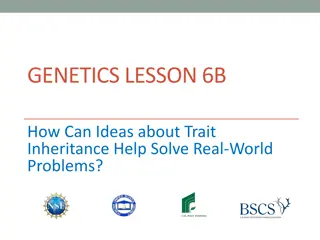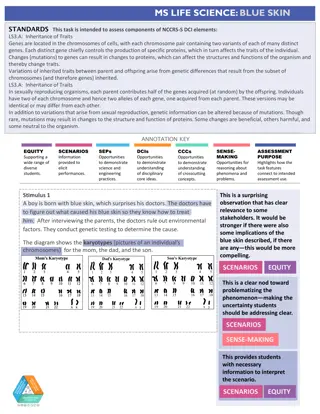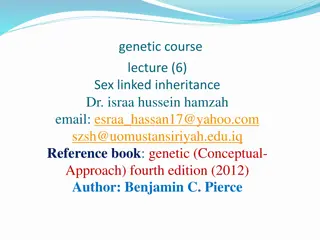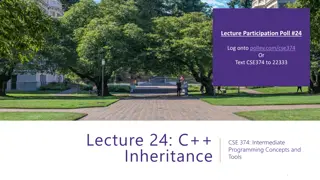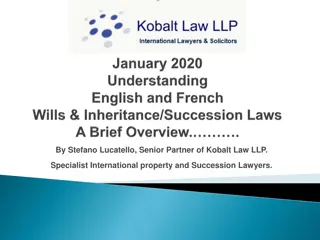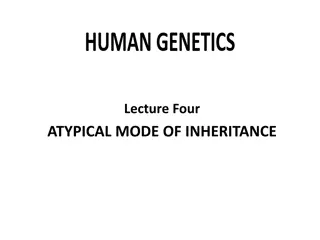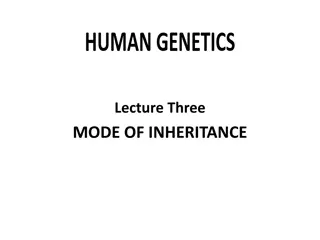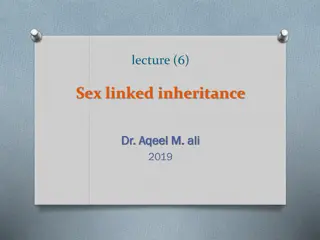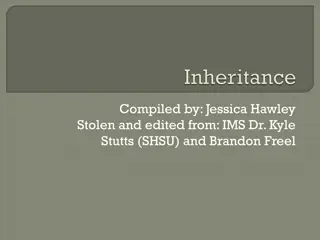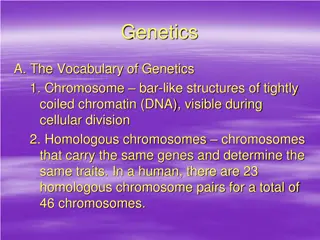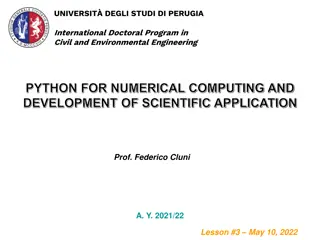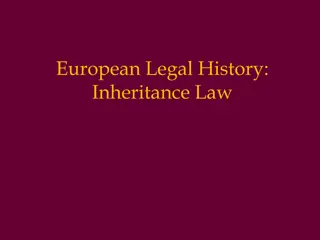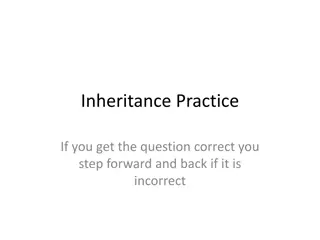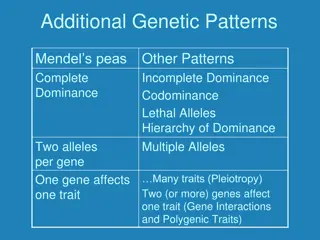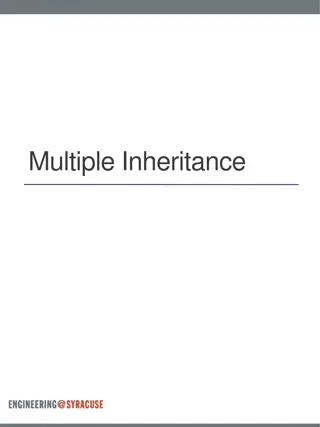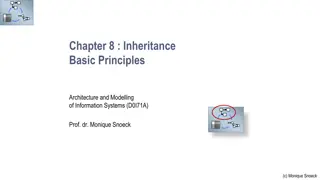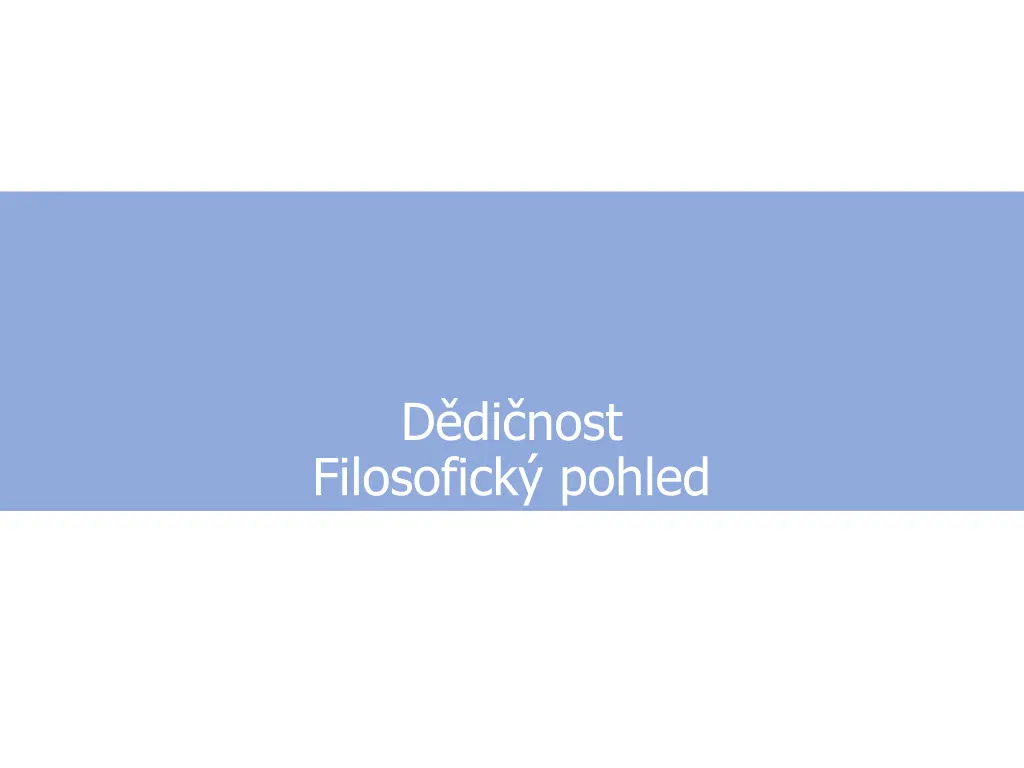
Understanding C++ Class Hierarchies and Object-Oriented Programming
Explore the concept of C++ class hierarchies and object-oriented programming, including inheritance, interfaces, and common pitfalls like slicing. Learn how to utilize these principles effectively for robust software design.
Download Presentation

Please find below an Image/Link to download the presentation.
The content on the website is provided AS IS for your information and personal use only. It may not be sold, licensed, or shared on other websites without obtaining consent from the author. If you encounter any issues during the download, it is possible that the publisher has removed the file from their server.
You are allowed to download the files provided on this website for personal or commercial use, subject to the condition that they are used lawfully. All files are the property of their respective owners.
The content on the website is provided AS IS for your information and personal use only. It may not be sold, licensed, or shared on other websites without obtaining consent from the author.
E N D
Presentation Transcript
Ddinost Filosofick pohled
Ddinost Mechanismus d di nosti v C++ je velmi siln B v pou v n i pro nevhodn ely Ide ln pou it d di nosti je pouze toto IS-A hierarchie (typicky pro objekty s vlastn identitou) ivo ich-Obratlovec-Savec-Pes-Jezev k Objekt-Viditeln -Editovateln -Polygon- tverec Vztah interface-implementace Readable-InputFile Writable-OutputFile (Readable+Writable)-IOFile
Ddinost IS-A hierarchie C++: Jednoduch nevirtu ln ve ejn d di nost class Derived : public Base Abstraktn t dy n kdy obsahuj datov polo ky Vztah interface-implementace C++: N sobn virtu ln ve ejn d di nost class Derived : virtual public Base1, virtual public Base2 Abstraktn t dy obvykle neobsahuj datov polo ky Interface neb vaj vyu v ny k destrukci objektu Oba p stupy se asto kombinuj class Derived : public Base, virtual public Interface1, virtual public Interface2
Ddinost Ide ln pou it d di nosti je pouze toto ISA hierarchie (typicky pro objekty s vlastn identitou) Vztah interface-implementace Jin pou it d di nosti obvykle signalizuj chybu v n vrhu V jimky samoz ejm existuj (traits...) Speci ln , d di nost nen spr vn m n strojem pro reusabilitu k du D vod nevhodnosti: automatick konverze potomek-p edek void f(container & k) { k.insert(/*...*/); } class improved_container : public container { public: void insert(/*...*/) { container::insert(/*...*/); index_.insert(/*...*/); } private: index_data index_; }; void g( improved_container & ik) { f(ik);} Probl m: Funkce f neaktualizuje index_ Kdyby funkce container::insert byla virtu ln , bylo by to funk n e en Pozn mka: Kvalifikovan jm no container::insert vyp n virtu ln vol n V C++ ale nechceme zbyte n platit za virtu ln funkce ztr tou v konnosti Spr vn e en je datov polo ka class improved_container { void insert(/*...*/) { c_.insert(/*...*/); index_.insert(/*...*/); } private: container c_; index_data index_; }; void g( improved_container & ik) { f(ik);} P ekladov chyba vynut reimplementaci f pro improved_container - lze i genericky: template< typename K> void f(K && k) { k.insert(/*...*/); }
Nesprvn uit ddinosti Nespr vn u it d di nosti . 1 class Real { public: double Re; }; class Complex : public Real { public: double Im; }; Poru uje pravidlo "ka d potomek m v echny vlastnosti p edka" nap . pro vlastnost "m nulovou imagin rn slo ku" D sledek - slicing: double abs( const Real & p) { return p.Re > 0 ? p.Re : - p.Re; } Complex x; double a = abs( x); // tento k d LZE p elo it, a to je patn D vod: Referenci na potomka lze p i adit do reference na p edka Complex => Complex & => Real & => const Real &
Nesprvn uit ddinosti Nespr vn u it d di nosti . 2 class Complex { public: double Re, Im; }; class Real : public Complex { public: Real( double r); }; Vypad jako korektn specializace: "ka d re ln slo m v echny vlastnosti komplexn ho sla" Chyba: Objekty v C++ nejsou hodnoty v matematice T da Complex m vlastnost "lze do mne p i adit Complex" Tuto vlastnost t da Real logicky nem m t, s touto d di nost ji m t bude void set_to_i( Complex & p) { p.Re = 0; p.Im = 1; } Real x; set_to_i( x); // tento k d LZE p elo it, a to je patn D vod: Referenci na potomka lze p i adit do reference na p edka Real => Real & => Complex &
Virtuln funkce class Base { virtual ~Base() noexcept {} virtual void f() { /* ... */ } }; class Derived : public Base { virtual void f() override { /* ... */ } }; Mechanismus virtu ln ch funkc se uplatn pouze v p tomnosti ukazatel nebo referenc Podstatou objektov ho programov n v jak mkoliv jazyce je konverze odkaz (ukazatel /referenc ) ve sm ru potomek-p edek std::unique_ptr<Base> p = std::make_unique< Derived>();// konverze ukazatel p->f(); // vol Derived::f V jin situaci nen virtu lnost funkc u ite n Derived d; d.f(); // vol Derived::f i kdyby nebyla virtu ln Base b = d; b.f(); // konverze zp sobuje slicing = kopie sti objektu // vol Base::f ikdy je virtu ln Slicing je specifikum jazyka C++ Je ne douc , ale nelze jej z jazyka odstranit Copy/move metody p edka... Base::Base(const Base &) ...v dy akceptuj reference na potomka
Two worlds of (instantiated) classes in C++ Classes without inheritance No virtual functions No visible pointers usually required When multiple objects exist Allocated usually via containers std::vector< MyClass> k; When standalone MyClass c; If ownership must be transferred, moving may be used std::vector< MyClass> k2 = move( k); MyClass c2 = std::move( c); Move required For insertion into containers For transfer of ownership Copy often required too Classes with inheritance Concrete classes of different size and layout Usually mixed in a data structure Cannot be allocated in a common block Individual dynamic allocation Common base class Serves as a unified handle for different concrete classes Pointers required std::vector<std::unique_ptr<Base>> k; Virtual destructor required Copy/move not required/supported Pointers are copied/moved instead Objects often have identity Individual allocation required only if ownership must be transferred and observers are required auto p = std::make_unique< MyClass>(); MyClass * observer = p.get(); auto p2 = move( p); User-defined operators useless class Base { public: virtual std::unique_ptr<Base> operator+(const Base &b) const=0; }; k[0] = *k[1] + *k[2]; // ??? User-defined operators may be used MyClass operator+( const MyClass & a, const MyClass & b); k[0] = k[1] + k[2];
Class NPRG041 Programov n v C++ - 2019/2020 David Bedn rek 9
Class class X { /*...*/ }; T da v C++ je velmi siln univerz ln konstrukce Jin jazyky v t inou m vaj n kolik slab ch (class+interface) Vy aduje opatrnost a dodr ov n konvenc T i stupn pou it konstrukce class Ne-instanciovan t da = bal k deklarac (pro generick programov n ) T da s datov mi polo kami a metodami (nej ast j pou it v C++) T das d di nost a virtu ln mi funkcemi (objektov programov n ) class = struct struct: prvky implicitn ve ejn konvence: neinstanciovan t dy a jednoduch t dy s daty class: prvky implicitn priv tn konvence: slo it t dy s daty a t dy s d di nost
Ti stupn pouit class T da nesouc data T dy s d di nost Neinstanciovan t da class Y { public: Y() : m_( 0) {} int get_m() const { return m_; } void set_m( int m) { m_ = m; } private: int m_; }; class X { public: using t = int; static constexpr int c = 1; static int f( int p) { return p + 1; } }; class U { public: virtual ~U() noexcept {} void g() { f_(); } private: virtual void f_() = 0; }; class V : public U { public: V() : m_( 0) {} private: int m_; virtual void f_() override { ++ m_; } }; NPRG041 Programov n v C++ - 2019/2020 David Bedn rek 11
Typy, konstanty a statick poloky ve tdch Typov a statick polo ky... nested class definitions typedef definitions static member constants static member functions static member variables ... nejsou v z ny na dnou instanci t dy (objekt) Ekvivalentn glob ln m typ m a prom nn m, ale Pou v ny s kvalifikovan mi jm ny (prefix X::) Zapouzd en chr n proti koliz m Ale namespace to dok e l pe N kter prvky mohou b t priv tn T dam e b t parametrem ablony class X { public: class N { /*...*/ }; typedef unsigned long t; using t2 = unsigned long; static constexpr t c = 1; static t f( t p) { return p + v_; } private: static t v_; // declaration of X::v_ }; X::t X::v_ = X::c; // definition of X::v_ void f2() { X::t a = 1; a = X::f( a); } NPRG041 Programov n v C++ - 2019/2020 12 David
Uninstantiated classes vs. namespaces Uninstantiated class Class definitions are intended for objects Static members must be explicitly marked Class members may be public/protected/private class X { public: class N { /*...*/ }; typedef unsigned long t; static const t c = 1; static t f( t p) { return p + v; } static t v; // declaration of X::v }; Class must be defined in one piece Definitions of class members may be placed outside X::t X::v = X::c; // definition of X::v Namespace Namespace members are always static No objects can be made from namespaces Functions/variables are not automatically inline/extern namespace X { class N { /*...*/ }; typedef unsigned long t; const t c = 1; extern t v; // declaration of X::v }; Namespace may be reopened Namespace may be split into several header files namespace X { inline t f( t p) { return p + v; } t v = c; // definition of X::v }; Namespace members can be made directly visible "using namespace" void f2() { using namespace X; t a = 1; a = f( a); } void f2() { X::t a = 1; a = X::f( a); } A class may become a template argument using T = some_generic_class< X>; NPRG041 Programov n v C++ - 2019/2020 13 David
Namespaces and name lookup namespace X { class N { /*...*/ }; typedef unsigned long t; const t c = 1; extern t v; inline t f( N p) { return p.m + v; } }; Namespace members can be made directly visible "using", "using namespace" Functions in namespaces are visible by argument-dependent lookup functions from a namespace may be visible even without "using" "using" on functions does not hide previously visible versions void f2() { X::N a; auto b = f( a); // calls X::f because the class type of a is a member of X using X::t; t b = 2; using namespace X; b = c; } // declaration of X::v NPRG041 Programmin g in C++ - 2019/2020 14 David
Class with data members Class (i.e. type) may be instantiated (into objects) Using a variable of class type Y v1; This is NOT a reference! Dynamically allocated Held by a (raw/smart) pointer Y* r = new Y; std::unique_ptr< Y> p = std::make_unique< Y>(); std::shared_ptr< Y> q = std::make_shared< Y>(); Element of a larger type typedef std::array< Y, 5> A; class C1 { public: Y v; }; class C2 : public Y {}; Embedded into the larger type NO explicit instantiation by new! class Y { public: Y() : m_( 0) {} int get_m() const { return m_; } void set_m( int m) { m_ = m; } private: int m_; }; NPRG041 Programov n v C++ - 2019/2020 16 David
Class with data members Class (i.e. type) may be instantiated (into objects) Y v1; std::unique_ptr<Y> p = std::make_unique<Y>(); Non-static data members constitute the object Non-static member functions are invoked on the object Object must be specified when referring to non-static members v1.get_m() p->set_m(0) References from outside may be prohibited by "private"/"protected" v1.m_ // error Only "const" methods may be called on const objects const Y * pp = p.get(); // secondary pointer pp->set_m(0) // error class Y { public: Y() : m_( 0) {} int get_m() const { return m_; } void set_m( int m) { m_ = m; } private: int m_; }; NPRG041 Programov n v C++ - 2019/2020 17 David
Special member functions Conversion constructors class T { T( U x); }; Generalized copy constructor Defines conversion from U to T If conversion effect is not desired, all one-argument constructors must be "explicit": explicit T( U v); Conversion operators class T { operator U() const; }; Defines conversion from T to U Returns U by value (using copy-constructor of U, if U is a class) U may be a reference like V& if life-time considerations allow Compilers will never use more than one user-defined conversion in a chain The user-defined conversion may be combined with several built-in conversions
Type cast Various syntax styles C-style cast (T)e Inherited from C Function-style cast T(e) Equivalent to (T)e T must be single type identifier or single keyword Type conversion operators Differentiated by intent (strength and associated danger) of cast: const_cast<T>(e) static_cast<T>(e) reinterpret_cast<T>(e) New - run-time assisted cast: dynamic_cast<T>(e)
Const cast const_cast<T>(e) Suppressing const flags of pointers/references const U & => U & const U * => U * It allows violation of const-ness In most cases, mutable is a better solution Example: Counting references to a logically constant object class Data { public: void register_pointer() const { references++; } private: /* ... data ... */ mutable int references; };
Static cast static_cast<T>(e) All implicit conversions Explicit cast used to enforce the conversion in ambiguous situations Loss-less and lossy number conversions (e.g. int <=> double) Adding const/volatile modifiers to pointers/references Pointer to void* Derived-to-base pointer/reference conversions Invoke any constructor of T capable to accept e Including copy/move-constructors and explicit constructors Invoke a conversion operator T() Some explicit conversions Anything to void, i.e. discarding the value (e.g. in a conditional expression) Base-to-derived pointer/reference conversions No runtime checks, it may produce invalid pointers use dynamic_cast to check Integer to an enumeration May produce undefined results if not mappable void* to any pointer No runtime checks possible (even if the object contain type information)
Dynamic cast dynamic_cast<T>(e) Base-to-derived pointer/reference conversions Runtime checks included requires type information in the e object At least one virtual function required in the type of e If the dynamic type of e is not T (or derived from T)... Pointers: Returns nullptr References: Throws std::bad_cast class Base { public: virtual ~Base(); /* base class must have at least one virtual function */ }; class X : public Base { /* ... */ }; class Y : public Base { /* ... */ }; Base * p = /* ... */; X * xp = dynamic_cast< X *>( p); if ( xp ) { /* ... */ } Y * yp = dynamic_cast< Y *>( p); if ( yp ) { /* ... */ }
Reinterpret cast reinterpret_cast<T>(e) Implementation-dependent conversions Pointer to integer Integer to pointer Any function-pointer to any function-pointer Any data-pointer to any other data-pointer No address correction even if pointers are related by inheritance Any reference to any other reference Mostly used to read/write binary files/packets/... void put_double( std::ostream & o, const double & d) { o.write( reinterpret_cast< char *>( & d), sizeof( double)); } The file contents is implementation-dependent not portable
Ddinost class Base { /* ... */ }; class Derived : public Base { /* ... */ } T da Derived je odvozena z t dy Base Obsahuje v echny datov polo ky i metody t dy Base M e k nim doplnit dal Nen vhodn nov mi zakr vat star , vyjma virtu ln ch M e zm nit chov n metod, kter jsou v Base deklarov ny jako virtu ln class Base { virtual ~Base() noexcept {} virtual void f() { /* ... */ } }; class Derived final : public Base { virtual void f() override { /* ... */ } }; final z kaz dal ch potomk override test existence t to virtu ln metody v n kter m p edku
Nzvoslov Abstraktn t da Definice v C++: T da obsahuj c alespo jednu ist virtu ln funkci N sledkem toho nesm b t samostatn instanciov na class Base { //... virtual void f() = 0; }; B n definice: T da, kter sama nebude instanciov na P edstavuje rozhran , kter maj z n odvozen t dy (potomci) implementovat Konkr tn t da T da, ur en k samostatn instanciaci Implementuje rozhran , p edepsan abstraktn t dou, ze kter je odvozena
Ddinost a destruktor { Base * p = new Derived; // ... delete p; } { std::unique_ptr<Base> p = std::make_unique< Derived>(); // ... // destruktor unique_ptr vol delete } Pokud je objekt destruov n oper torem delete aplikovan m na ukazatel na p edka, mus b t destruktor v tomto p edku deklarov n jako virtu ln class Base { public: virtual ~Base() noexcept {} // ... }; class Derived : public Base { public: // ... }; Odvozen pravidlo: Ka d abstraktn t da m m t virtu ln destruktor Je to zadarmo M e se to hodit
Single non-virtual inheritance - example class S { public: virtual ~S() = default; virtual void seek(int) = 0; }; R S S S seek S-in-R seek class R : public S { public: virtual int read() = 0; }; R read p r s C class C : public R { virtual void seek(int) {/**/} virtual int read() {/**/} std::istream d_; }; R S d_ S-in-C C::seek R-in-C C::read auto p = std::make_unique<C>(); std::unique_ptr<R> r = move(p); S* s = &*r; r.reset(); // C::~C() C
Multiple non-virtual inheritance - example class S { public: virtual ~S() = default; virtual void seek(int) = 0; }; R W S S S S seek S-in-R seek S-in-W seek class R : public S { public: virtual int read() = 0; }; R read W write class W : public S { public: virtual void write(int) = 0; }; M R W S S S-in-M seek S-in-M seek class M : public R, public W { virtual void seek(int) {/**/} // ERROR: which seek? }; R-in-M read W-in-M write M
Virtual inheritance - example off-RS off-WS class S { public: virtual ~S() = default; virtual void seek(int) = 0; }; R S W S R read off-RS S-in-R seek W write off-WS S-in-W seek class R : public virtual S { public: virtual int read() = 0; }; class W : public virtual S { public: virtual void write(int) = 0; }; off-MW off-RS off-WS off-MR M R W S class M : public virtual R, public virtual W {}; R-in-M read off-RS W-in-M write off-WS S-in-M seek M off-MR off-MW off-MS void copy(W &, R &); void sort(M &);


